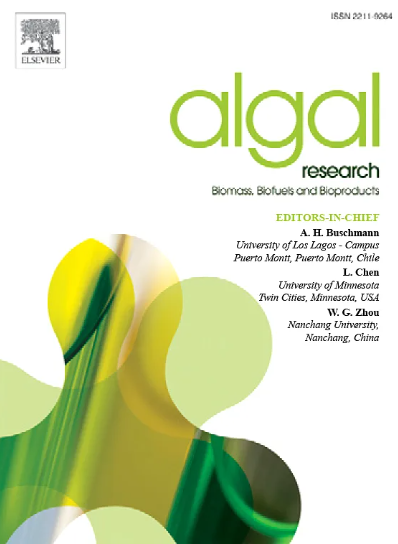Deep sequencing analysis of chloroplast transcription and splicing in Euglena gracilis
IF 4.6
2区 生物学
Q1 BIOTECHNOLOGY & APPLIED MICROBIOLOGY
Algal Research-Biomass Biofuels and Bioproducts
Pub Date : 2024-11-13
DOI:10.1016/j.algal.2024.103804
引用次数: 0
Abstract
The transcription and splicing of the Euglena gracilis (E. gracilis) chloroplast have been studied only on the scale of individual genes, and a comprehensive genome-scale analysis is lacking. We addressed this question in this study using transcriptomic RNA sequencing (RNA-seq) technology. Upon mapping tens of millions of RNA-seq reads onto the E. gracilis chloroplast genome, the transcription of protein-coding genes, including monocistronic genes and genes in operons, was visualized, and the expression levels of these genes were quantified. The splicing of intron-containing genes in the E. gracilis chloroplast genome was also visualized and quantified, with introns, including some twintrons, and exons being clearly discerned. The correct coding sequences of psbD, rpl23 and rpl16 were deduced based on read coverage of the corresponding genes and confirmed experimentally. Additionally, a new group III intron was identified from the 5’ UTR of petB. This study updates our knowledge on the transcription and splicing of the E. gracilis chloroplast, and will be instrumental in the mechanistic exploration of gene transcription and intron splicing in the E. gracilis chloroplast.
叶绿体转录和剪接的深度测序分析
对褐飞虱叶绿体转录和剪接的研究仅局限于单个基因的范围,缺乏基因组范围的全面分析。在本研究中,我们利用转录组 RNA 测序(RNA-seq)技术解决了这一问题。在将数千万个 RNA-seq 读数映射到 E. gracilis 叶绿体基因组上后,蛋白质编码基因(包括单核苷酸基因和操作子中的基因)的转录被可视化,这些基因的表达水平也被量化。此外,还对 E. gracilis 叶绿体基因组中含有内含子的基因的剪接进行了可视化和量化,内含子(包括一些双电子)和外显子清晰可辨。根据相应基因的读数覆盖率推断出了 psbD、rpl23 和 rpl16 的正确编码序列,并通过实验得到了证实。此外,还从 petB 的 5' UTR 中发现了一个新的第 III 组内含子。这项研究更新了我们对 E. gracilis 叶绿体转录和剪接的认识,将有助于对 E. gracilis 叶绿体中基因转录和内含子剪接的机理进行探索。
本文章由计算机程序翻译,如有差异,请以英文原文为准。
求助全文
约1分钟内获得全文
求助全文
来源期刊

Algal Research-Biomass Biofuels and Bioproducts
BIOTECHNOLOGY & APPLIED MICROBIOLOGY-
CiteScore
9.40
自引率
7.80%
发文量
332
期刊介绍:
Algal Research is an international phycology journal covering all areas of emerging technologies in algae biology, biomass production, cultivation, harvesting, extraction, bioproducts, biorefinery, engineering, and econometrics. Algae is defined to include cyanobacteria, microalgae, and protists and symbionts of interest in biotechnology. The journal publishes original research and reviews for the following scope: algal biology, including but not exclusive to: phylogeny, biodiversity, molecular traits, metabolic regulation, and genetic engineering, algal cultivation, e.g. phototrophic systems, heterotrophic systems, and mixotrophic systems, algal harvesting and extraction systems, biotechnology to convert algal biomass and components into biofuels and bioproducts, e.g., nutraceuticals, pharmaceuticals, animal feed, plastics, etc. algal products and their economic assessment
 求助内容:
求助内容: 应助结果提醒方式:
应助结果提醒方式:


